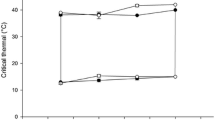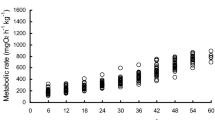Abstract
Standard metabolic rate of Greenland cod or uvak, Gadus ogac, polar cod, Boreogadus saida, Atlantic cod, Gadus morhua, and sculpin, Myxocephalus scorpius, caught in the same geographical area on the west coast of Greenland was measured at 4.5°C, the temperature at which the fish were caught. The present data does not support the Metabolic Cold Adaptation theory in the traditional sense of the standard metabolic rate being 2–4 times higher for Arctic fishes than for temperate species. The standard metabolic rate of the two exclusively Arctic species of teleosts was only 10% and 26% higher, respectively, than the two species that occur in temperate as well as Arctic areas. The critical oxygen tension, with respect to oxygen consumption, of resting uvak was between 50 and 60 mmHg, and the lethal oxygen tension 20–25 mmHg at 4.5°C, which is considerably higher than for Atlantic cod from a temperate area measured at the same temperature.
Similar content being viewed by others
References
Bushnell PG, Steffensen JF, Schurmann H, Jones DR Exercise metabolism in the two species of cod in Arctic waters. Polar Biol 14:43–48
Clarke A (1983) Life in cold water: The physiological ecology of polar marine ectotherms. Oceanogr Mar Biol Ann Rev 21:341–453
Clarke A (1991) What is cold adaptation and how should we measure it? Am Zool 31:81–92
Craig PC, Griffiths WB, Haldorsen L, McElderly H (1982) Ecological studies of Arctic cod (Boreogadus saida) in Beaufort sea coastal waters, Alaska. Can J Fish Aquat Sci 39:395–406
Ege R, Krogh A (1914) On the relation between the temperature and the respiratory exchange in fishes. Int Rev Gesamten Hydrobiologie Hydrog 1:48–55
Forster ME, Franklin CE, Taylor HH, Davison W (1987) The aerobic scope of an Antarctic fish, Pagothenia borchgrevinki, and its significance for metabolic cold adaptation. Polar Biol 8:155–159
Heusner AA (1991). Size and power in animals. J exp Biol 160:25–54
Hochachka PW (1988) Channels and pumps — determinants of metabolic cold adaptation strategies. Comp Biochem Physiol 90B:515–519
Holeton GF (1973) Respiration of Arctic charr (Salvelinus alpinus) from a high arctic lake. J Fish Res Bd Can 6:717–723
Holeton GF (1974) Metabolic cold adaptation of polar fish: Fact or artefact? Phys Zool 47:137–152
Job SV (1955) The oxygen consumption of Salvelinus fontinalis. Publ Ontario Fish Res Lab 73 Univ Toronto Studies, Biol Ser 61:1–39
Krogh A (1916) The respiratory exchange of animals and man. London, Longmans, pp 173
Leim AH, Scott WB (1966) Fishes of the Atlantic Coast of Canada. Fish Res Bd Can 155:189–200
Morris DJ, North AW (1984) Oxygen consumption of five species of fish from South Georgia. J Exp Mar Biol Ecol 78:75–86
Saunders RL (1963) Respiration of the Atlantic cod. J Fish Res Bd Can 23:869–908
Scholander PF, Flagg W, Walters V, Irving L (1953) Climatic adaptations in arctic and tropical poikilotherms. Physiol Zool 26:67–92
Schmidt-Nielsen K (1984) Scaling: Why is animal size so important? Cambridge University Press 241 p
Schurmann H, Steffensen JF (1992) Lethal oxygen levels at differennt temperatures and the preferred temperature during hypoxia of the Atlantic cod, Gadus morhua. J Fish Biol 41:927–934
Soofiani NM, Hawkins AD (1982) Energetic costs at different levels of feeding in juvenile cod, Gadus morhua. J Fish Biol 21:577–592
Soofiani NM, Priede IG (1985) Aerobic metabolic scope and swimming performance in juvenile cod, Gadus morhua. J Fish Biol 26:127–138
Steffensen JF (1989) Some errors in respirometry of aquatic breathers: how to avoid and correct for them. Fish Physiol Biochem 6:49–59
Steffensen JF, Johansen K, Bushnell PG (1984) An automated swimming respirometer. Comp Biochem Physiol 79A:437–440
Torres JJ, Somero GN (1988) Metabolism, enzymic activities and cold adaptation in Antarctic fishes. Mar Biol 98:169–180
Wells RMG (1987) Respiration of Antarctic fishes from McMurdo Sound. Comp Biochem Physiol 88A:417–424
Wells RMG, Grigg GC, Beard LA, Summers G (1989) Hypoxic responses in a fish from a stable environment: blood oxygen transport in the Antarctic fish Pagothenia borchgrevinki. J Exp Biol 141:97–11
Winberg GG (1956) Rate of metabolism and food requirements of fishes. Fish Res Bd Can Trans Ser 194, 202 p
Wohlschlag DE (1960) Metabolism of an Arctic fish and the phenomenon of cold adaptation. Ecology 41:287–292
Wohlschlag DE (1963) An Antarctic fish with unusually low metabolism. Ecology 44:557–564
Wohlschlag DE (1964) Respiratory metabolism and ecological characteristics of some fishes in McMurdo Sound, Antarctica. In: Biology of the Antarctic Seas. Ed.: Lee, M.O. Vol. 1, pp. 33–62. American Geophysical Union, Washington, DC
Author information
Authors and Affiliations
Rights and permissions
About this article
Cite this article
Steffensen, J.F., Bushnell, P.G. & Schurmann, H. Oxygen consumption in four species of teleosts from Greenland: no evidence of metabolic cold adaptation. Polar Biol 14, 49–54 (1994). https://doi.org/10.1007/BF00240272
Accepted:
Issue Date:
DOI: https://doi.org/10.1007/BF00240272




